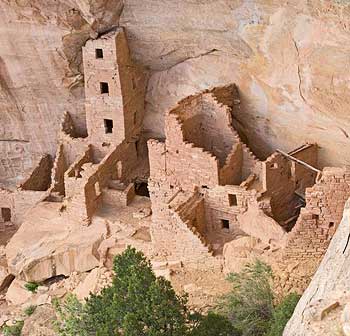
|
|
| Square Tower House. |
About 1,400 years ago, long before Europeans explored North America, a group of people living in the Four Corners region chose Mesa Verde for their home. For more than 700 years they and their descendants lived and flourished here, eventually building elaborate stone communities in the sheltered alcoves of the canyon walls. Then, in the late A.D. 1200s, in the span of a generation or two, they left their homes and moved away.
Mesa Verde National Park preserves a spectacular reminder of this ancient culture. Archeologists have called these people Anasazi, from a Navajo word sometimes translated as "the ancient ones" or "ancient enemies." We now call them Ancestral Puebloans, reflecting their modern descendants.
The First Ancestral Puebloans in Mesa Verde
The first Ancestral Puebloans settled in Mesa Verde (Spanish for "green table") about A.D. 550. They are known as Basketmakers for their skill at the craft. Formerly nomadic, they were beginning to lead a more settled way of life. Farming replaced hunting and gathering as their main livelihood. They lived in pithouses clustered into small villages usually built on mesa tops but sometimes in cliff recesses. They learned to make pottery and acquired the bow and arrow, a more efficient weapon for hunting than the atlatl, a spear thrower.These were fairly prosperous times for the Basketmakers, and their population multiplied. About A.D. 750 they began building houses above ground, with upright walls made of poles and mud. They built the houses one against another in long, curving rows, often with a pithouse or two in front. (Pithouses would later evolve into kivas.) From here on, these people are known as Puebloans, a Spanish word meaning "village dwellers."
By A.D. 1000 the people of Mesa Verde had advanced from pole-and-adobe construction to skillful stone masonry. Walls of thick, double-coursed stone often rose two or three stories high and were joined together into units of 50 rooms or more. Pottery also changed, from simple designs on a dull gray background to black drawings on a white background. Farming accounted for more of their diet than before, and much mesa-top land was cleared for agriculture.
Between A.D. 1100 and A.D. 1300, during the Classic Period, the population may have reached several thousand. It was mostly concentrated in compact villages of many rooms, often with the kivas built inside the enclosing walls rather than out in the open. The stone walls of the large pueblos are regarded as the finest ever built in Mesa Verde, with their straight courses of carefully shaped stones. Baskets show evidence of decline in quality, possibly because widespread use of pottery meant less attention to the craft. About A.D. 1200, another major population shift saw people begin to move back into the cliff alcoves that sheltered their ancestors centuries before. Why did they make this move? We don't know. Perhaps it was for defense; perhaps it was for religious or psychological reasons; perhaps alcoves offered better protection from the elements. Whatever the reason, or reasons, it gave rise to the cliff dwellings for which Mesa Verde is most famous.